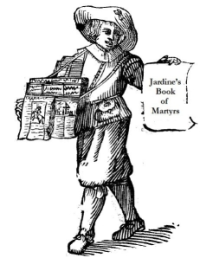The ‘Thirteen Drifty Days’ and the ‘Vehement Frost’ of 1674
For over a month in early 1674, ‘a vehement frost’ descended on Scotland. In the upland parishes of the south and the Highlands, families froze to death and cattle, sheep and wild animals died in great numbers. The bad weather began a month before:
‘January 1674. The beginning of it there was great storms, and snow; the wind fra the east, and great loss at sea, to the number of 20 saill (in 24 hours tyme) of ships cast away ‘twixt Newcastle and the Bass in Scotland.’ (Law, Memorialls, 60.)
The violent storm off the east coast of Scotland was followed by the ‘vehement frost’ in the next month:
‘February 20,1674, fell on a great storm of snow and a vehement frost, which continued till the 29th day of March; all fresh waters was frozin as if in the midst of winter; all plowing and delving the ground was marr’d till the foresaid day; much loss of sheep by the snow, and of whole families in the moor country and hy lands; much loss of cowes every where, also of weild beasts, as do and roe.’ (Law, Memorialls, 63.)
‘The Thirteen Drifty Days’
Its impact may have been similar to that of James Hogg’s ‘Thirteen Drifty Days’, a seventeenth-century snowstorm that was remembered well over a century later:
‘The most dismal of all those on record is the thirteen drifty days. This extraordinary storm, as near as I have been able to trace, must have occurred in the year 1620. The traditionary stories and pictures of desolation that remain of it, are the most dire imaginable; and the mentioning of the thirteen drifty days to an old shepherd, in a stormy winter night, never fails to impress his mind with a sort of religious awe, and often sets him on his knees before that Being who alone can avert such another calamity. —It is said, that for thirteen days and nights the snow-drift never once abated— the ground was covered with frozen snow when it commenced, and during all that time the sheep never broke their fast. The cold was intense to a degree never before remembered; and about the fifth and sixth days of the storm, the young sheep began to fall into a sleepy and torpid state, and all that were so affected in the evening died over night. The intensity of the frost wind often cut them off when in that state quite instantaneously. About the ninth and tenth days, the shepherds began to build up huge semicircular walls of their dead, in order to afford some shelter for the remainder of the living; but they availed but little, for about the same time they were frequently seen tearing at one another’s wool with their teeth. —When the storm abated, on the fourteenth day from its commencement, there was on many a high-lying farm not a living sheep to be seen. Large mishapen walls of dead, surrounding a small prostrate flock likewise all dead, and frozen stiff in their lairs, were all that remained to cheer the forlorn shepherd and his master; and though on low-lying farms, where the snow was not so hard before, numbers of sheep weathered the storm, yet their constitutions received such a shock, that the greater part of them perished afterwards; and the final consequence was, that about nine-tenths of all the sheep in the South of Scotland were destroyed. — In the extensive pastoral district of Eskdale-moor, which maintains upwards of 20,000 sheep, it is said none were left alive, but forty young wedders on one farm, and five old ewes on another.’ (James Hogg in Gentleman’s Magazine, Vol. XC, Part 2.)
For other wonders of the 1670s and 1680s, see here.
Text © Copyright Dr Mark Jardine. All Rights Reserved. Please link to this post on Facebook or other social networks or retweet it, but do not reblog in FULL without the express permission of the author @drmarkjardine



[…] Gamkonora’a Possible Impact on Scotland In early 1674, a vehement frost descended on the country that lasted for a biblical forty days. In the upland parishes of the South and the Highlands, families froze to death and cattle, sheep […]
The Volcano that Made Scotland Freeze in 1674 #History | Jardine's Book of Martyrs said this on October 4, 2015 at 10:45 pm |